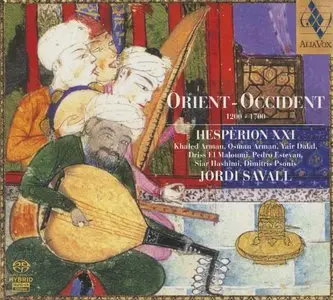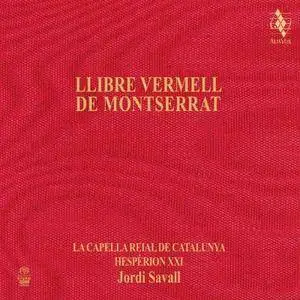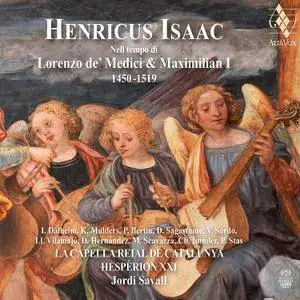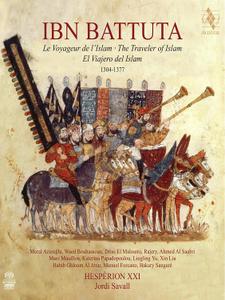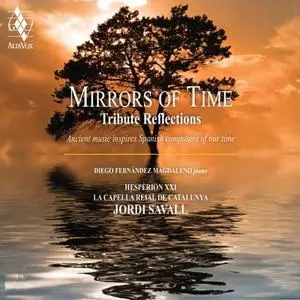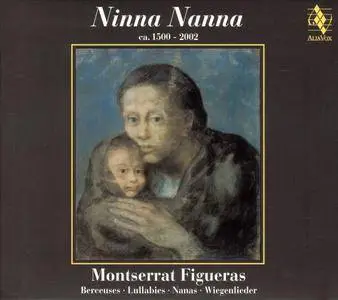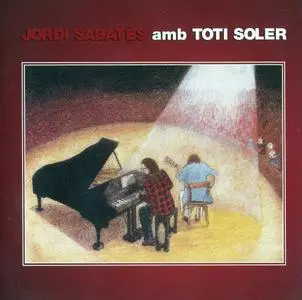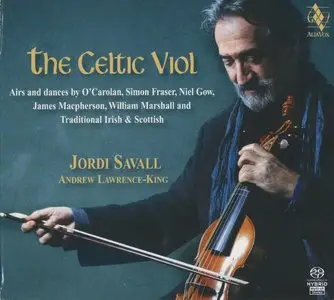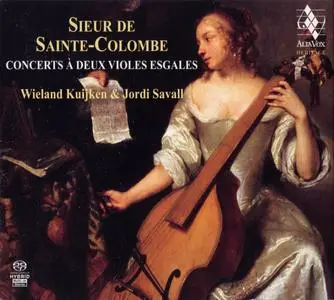Jordi
Jordi Savall & Hesperion XXI - Orient-Occident 1200-1700 (2006) {Alia Vox} Music
Posted by ruskaval at Dec. 20, 2015
Jordi Savall & Hesperion XXI - Orient-Occident 1200-1700 (2006) {Alia Vox}
EAC rip (secure mode) | FLAC (tracks)+CUE+LOG -> 415 Mb | MP3 @320 -> 181 Mb
Full Artwork @ 600 dpi (png) -> 535 Mb | 5% repair rar
© 2006 Alia Vox | AVSA 9848
Classical / World Music / Medieval
This remarkable recording, which juxtaposes 13th- and 14th-century Spanish and Italian monodic instrumental pieces with similar ones from various living Eastern traditions, reveals the extraordinary extent to which they share a common musical language. Indeed, as a Persian or Moroccan dance is followed by an Italian istampitta or Spanish saltarello, an innocent ear would often struggle to decide which piece originated where - proof that to travel in space is to travel in time.
Jordi Savall - Llibre Vermell de Montserrat (2016) Music
Posted by tomashass at Dec. 2, 2016
Jordi Savall - Llibre Vermell de Montserrat (2016)
MP3 320 kbps CBR | 01:11:44 | 166 MB
Genre: Classical, Medieval Era, Sacred | Label: Alia Vox
MP3 320 kbps CBR | 01:11:44 | 166 MB
Genre: Classical, Medieval Era, Sacred | Label: Alia Vox
Jordi Savall is among the leading instrumentalists and conductors of the European early music scene, specializing in Renaissance and medieval music. He began studying music when he was six, learning cello and pursuing that instrument at the Barcelona Conservatory. He took an interest in early music, and began learning the viola da gamba. That instrument possesses approximately the same range and similar playing technique as the cello, but instead of being a member of the violin family is part of the related, older family of stringed instruments, the viol family, visually most easily distinguished from their cousins by their sloping shoulder lines.
Jordi Savall - Henricus Isaac: Nel tempo di Lorenzo de Medici & Maximilian I (2017) Music
Posted by SERTiL at May 5, 2017
Jordi Savall - Henricus Isaac: Nel tempo di Lorenzo de Medici & Maximilian I
Classical, Renaissance, Sacred | WEB FLAC (tracks) & d. booklet | 75:56 min | 178 MB
Label: Alia Vox | Tracks: 15 | Rls.date: 2017
Classical, Renaissance, Sacred | WEB FLAC (tracks) & d. booklet | 75:56 min | 178 MB
Label: Alia Vox | Tracks: 15 | Rls.date: 2017
Discover the music of Heinrich Isaac with these authentic performances from La Capella Reial de Catalunya and Hespèrion XXI under the inspired direction of early music specialist Jordi Savall. This program paints a portrait of an era during which the Hundred Year's War ended, the Medici family reached its peak, the idea of the Reformation surged and Charles V was crowned at the head of an Empire that redefined the idea of Europe.
Jordi Savall & Hespèrion XXI - Ibn Battuta, The Traveller of Islam, 1304-1377 (2019) {Alia Vox AVSA9930, SACD} Music
Posted by ruskaval at March 21, 2019
Jordi Savall & Hespèrion XXI - Ibn Battuta, The Traveller of Islam, 1304-1377 (2019) {Alia Vox AVSA9930, SACD}
SACD rip | FLAC (tracks, 16-48) -> 783 Mb | MP3 @320 -> 357 Mb
Full Artwork @ 600 dpi (jpg+pdf) -> 797 Mb | 5% repair rar
© 2019 Alia Vox | AVSA 9930
Classical / Medieval / World Music
Ibn Battuta had the same significance in the Muslim world as Marco Polo in the Western countries. A relentless traveler, he deeply changed the perception of the Orient among his contemporaries and the following generations. Morocco, Mali, Egypt, Yemen, Zanzibar, India, The Maldives and China: this non-exhaustive list gives us a hint about the extraordinary journey Jordi Savall invites us on.
Jordi Savall - Mirrors of Time (2024) Music
Posted by ciklon5 at March 28, 2024
Jordi Savall - Mirrors of Time (2024)
FLAC (tracks), Lossless | 2:36:39 | 577 Mb
Genre: Classical
FLAC (tracks), Lossless | 2:36:39 | 577 Mb
Genre: Classical
Ancient music inspires Spanish composers of our time, and this double-album features some of the finest Alia Vox recordings alternating with pieces written by contemporary composers and inspired by these very recordings. Performed on piano by Diego Fernández Magdaleno with Hespèrion XXI and La Capella Reial de Catalunya led by Jordi Savall, this program is a fascinating journey through music and time.
Jordi Savall & Hesperion XXI - Jeanne D'Arc: Batailles & Prisons (2012) {2CD Set Alia Vox AVSA 9891 A+B} Music
Posted by ruskaval at May 21, 2018
Jordi Savall & Hesperion XXI - Jeanne D'Arc: Batailles & Prisons (2012) {2CD Set Alia Vox AVSA 9891 A+B}
EAC rip (secure mode) | FLAC (tracks)+CUE+LOG -> 604 Mb | MP3 @320 -> 317 Mb
Full Artwork @ 300 dpi (jpg) -> 0.98 Gb | 5% repair rar
© 2012 Alia Vox | AVSA 9891 A+B
Classical / Chamber Music / Medieval / Renaissance
Twenty years after his work on the soundtrack of Jacques Rivette's movie Jeanne la Pucelle, Jordi Savall returns to this powerful subject matter and presents a new set dedicated to the mother figure of the struggle for French independence. The music on Joan of Arc - Battles and Prisons provides the perfect atmosphere for Savall's fresh look this historical icon. Alongside works by composers from the time of Joan of Arc (Guillaume Dufay, Josquin Desprez, Johannes Vincenet, Johannes Cornago, etc.), the set also features compositions and arrangements by Jordi Savall. The biographical program of the set is further illustrated through spoken dialogue. The accompanying 500 page, six language hardbound book is richly illustrated and provides historical perspective as well as texts and translations. The result is an amazingly vivid portrait of a troubled time.
Montserrat Figueras & Jordi Savall - Ninna Nanna (ca. 1500-2002) {Alia Vox AV 9826 rel 2002} Music
Posted by ruskaval at March 24, 2018
Montserrat Figueras & Jordi Savall - Ninna Nanna (ca. 1500-2002) {Alia Vox AV 9826 rel 2002}
EAC rip (secure mode) | FLAC (tracks)+CUE+LOG -> 340 Mb | MP3 @320 -> 182 Mb | Artwork | 5% repair rar
© 2002 Alia Vox | AVSA 9826
Classical / Vocal Music
Who doesn't love a lullaby? As a tribute "to all mothers and children", singer Montserrat Figueras offers this unusual program of 18 such songs from diverse sources and anonymous composers–Portuguese, English, Greek, Catalan, Hebrew, Sephardic, and North African–as well as pieces written by the likes of Byrd, Mussorgsky, Reger, Falla, Milhaud, and Pärt (two lullabies composed for this recording). Accompaniments show the stylish hand and always-tasteful imaginings of Jordi Savall and the instrumentalists of Hesperion XXI–viols, guitar, flutes, psaltery, harp–and, in three tracks, the piano of Paul Badura-Skoda. Although the liner notes prime us to expect very simple, repetitive tunes, Figueras transforms these ostensibly sleep-inducing songs into high, mind-and-ear-engaging art, embellishing, shaping, and imbuing them with deeply felt expression, sometimes wistful and at others fervent, but always delivered as if in intimate, personal touch with her listener(s).
Jordi Sabates i Toti Soler - Jordi Sabates amb Toti Soler (1973) {Picap 910694-02 rel 2008} Music
Posted by ruskaval at Sept. 25, 2019
Jordi Sabates i Toti Soler - Jordi Sabates amb Toti Soler (1973) {Picap 910694-02 rel 2008}
EAC rip (secure mode) | FLAC (tracks)+CUE+LOG -> 187 Mb | MP3 @320 -> 93 Mb
Full Artwork @ 600 dpi (jpg) -> 35 Mb | 5% repair rar
© 1973, 2008 Edigsa / Picap | 910694-02
Jazz / Contemporary Jazz / World Fusion / Flamenco / Piano / Guitar
How do I start talking about this compact and capital work? Perhaps saying that the magnificent cover, a drawing by Jordi Graells, in which the pair of musicians on stage, on the back, under a light bulb, is playing in an empty room (well, there are four cats), the I have framed and hung in my studio …? It was in 1973, neither the Mirasol Orchestra nor the Dharma existed yet. So, as today, open-minded adventures were a matter of four cats. It is what it touches when it lacks the parameters of the pop and the law of the majorities. This record has nothing to do with it.
Jordi Savall & Andrew Lawrence-King - The Celtic Viol (2009) {Alia Vox AVSA 9865} Music
Posted by ruskaval at Feb. 23, 2020
Jordi Savall & Andrew Lawrence-King - The Celtic Viol (2009) {Alia Vox AVSA 9865}
EAC rip (secure mode) | FLAC (tracks)+CUE+LOG -> 421 Mb | MP3 @320 -> 182 Mb
Full Artwork @ 600 dpi (jpg) -> 92 Mb | 5% repair rar
© 2009 Alia Vox | AVSA 9865
Classical / Chamber Music / Celtic / World
Thanks to in-depth research into original manuscripts, Jordi Savall reveals the hidden beauties of Irish and Scottish music from 17th to 19th Century. The transcription from fiddle to baroque viol sounds so obvious that everyone realizes the closeness of traditional and ancient repertoires at once. Some of the pieces are irresistibly vivid and virtuosic, some are more melancholic-but all of them deserve the renasissance Jordi Savall offers them in this collection, where he partners with harp virtuoso Andrew Lawrence-King.
Jordi Savall & Wieland Kuijken - Sieur de Sainte-Colombe: Concerts a deux Violes Esgales (2011) {2CD Set Alia Vox AVSA9885} Music
Posted by ruskaval at Aug. 2, 2019
Jordi Savall & Wieland Kuijken - Sieur de Sainte-Colombe: Concerts a deux Violes Esgales (2011) {2CD Set Alia Vox AVSA9885}
EAC rip (secure mode) | FLAC (tracks)+CUE+LOG -> 585 Mb | MP3 @320 -> 275 Mb
Full Artwork @ 300 dpi (jpg) -> 67 Mb | 5% repair rar
© 2011 Alia Vox | AVSA 9885 A+B
Classical / Baroque / Period Instruments / Chamber Music / Viola da gamba
These albums were recorded in 1976 and 1992 (the latter right after the tremendous success of the movie “Tous les Matins du Monde”. Nevertheless, they are astonishingly consistent in their interpretative flair and enable us to discover 10 of the 67 “Concerts” composed by Mr. de Sainte Colombe. Each ‘Concert’ consists in an average of 4 pieces and last around 10 minutes. The most famous is the Concert: ‘Le Tombeau des Regrets’ and especially ‘Les Pleurs’ (The Tears), a masterpiece of emotion in which every note is essential. Jordi Savall plays alongside with Wieland Kuijken, another great name of Baroque music and Viola.
